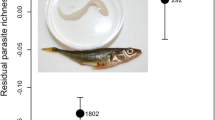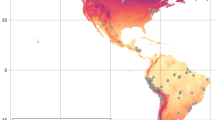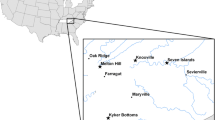Abstract
Across the Pacific the invading gecko species Hemidactylus frenatus has competitively displaced the resident gecko species Lepidodactylus lugubris in urban/surburban habitats. Do parasites enhance, inhibit, orhave no effect on this invasion? Parasites can confer an advantage to an invading species when the invader (1) introduces a new parasite to a resident species that has a greater detrimental effect on the resident than the invader, (2) is less susceptible to endemic parasites than the resident, and/or (3) increases the susceptibility of the resident to parasites. Conversely, parasites may protect a resident against invasion when endemic parasites have a greater impact on the invader than the resident. We screened more than one thousand H. frenatus and L. lugubris in areas of sympatry and allopatry from 28 islands and 5 sites on mainland Asia for a broad array of blood parasites, coccidia and helminths in order to evaluate the potential for parasites to affect their interaction. We found that 1) There were no parasites which appear to protect L. lugubris against invasion by H. frenatus. 2) H. frenatus does not introduce the same parasite to L. lugubris in every location where the two come in to contact, but probably has introduced different parasites in different locations. L. lugubris also seems to have introduced at least one parasite to H. frenatus. 3) The prevalence of parasite species shared by the two hosts is generally higher in H. frenatus; however, prevalence is determined by many factors and cannot be directly translated as susceptibility. We discuss the implications of this difference in prevalence for the Red Queen hypothesis. 4) The prevalence of the cestode Cylindrotaenia sp. is significantly higher in L. lugubris that are sympatric with H. frenatus than those which are allopatric.
Similar content being viewed by others
References
Abacus Concepts, Inc. (1993) Statview version 4.01. Berkeley, California
Abacus Concepts, Inc. (1991) Super ANOVA version 1.11 Berkeley, California
Aho JM (1990) Helminth communities of amphibians and reptiles: comparative approaches to understanding patterns and processes. In: Esch GW, Bush AO, Aho JM (eds) Parasite communities: patterns and processes. Chapman and Hall, New York, pp 157–196
Anderson RC (1972) The ecological relationships of meningeal worms and native cervids in North America. J Wildl Dis 8: 304–310
Anderson RM (1982) Epidemiology. In: Cox FEG (ed) Modern parasitology. Blackwell Oxford, pp 204–251
Anderson RM, May RM (1982) Coevolution of hosts and parasites. Parasitology 85:411–426
Bender EA, Case TJ, Gilpin ME (1984) Perturbation experiments in community ecology: theory and practice. Ecology 65:1–13
Bolger DT, Case TJ (1992) Intra-specific and inter-specific interference behavior among sexual and asexual geckos. Anim Behav 44:21–30
Bursey CB, Goldberg SR (1992a) Monthly prevalences of Spauligodon giganticus (Nematoda, Pharyngodonidae) in naturally infected Yarrow's spin lizard Sceloporous jarrovii jarrovii (Iguanidae). Am Midl Nat 127:204–207
Bursey CB, Goldberg SR (1992b) Oochoristica islandensis n. sp. (Cestoda: Linstowiidae) from the island night lizard, Xantusia riversiana (Sauria: Xantusiidae). Trans Am Microsc Soc 111: 302–313
Case TJ, Bolger DT, Petren K (1994) Invasions and competitive displacement among house geckos in the tropical Pacific. Ecology 75: 464–477
Clayton DH, Pruett-Jones SG, Lande R (1992) Reappraisal of the interspecific prediction of parasite-mediated sexual selection: opportunity knocks. J Theor Biol 157:95–108
Dye T, Steadman DW (1990) Polynesian ancestors and their animal world. Am Sci 78:207–215
Fienberg SE (1969) Preliminary graphical analysis and quasi-independence for two-way contingency tables. Appl Stat 18: 153–168
Goldberg SR, Bursey CR (1988) Larval nematodes (Ascarops sp., Spirurida, Spirocercidae) in liver granulomata of the western fence lizard Sceloporus occidentalis (Iguanidae). J Wildl Dis 24:568–571
Goldberg SR, Bursey CR (1989) Larval nematodes (Ascarops sp.) in stomach granulomas of the sagebrush lizard, Sceloporus graciosus. J Wildl Dis 25:630–633
Grosholz ED (1992) Interactions of intraspecific, interspecific and apparent competitions with host-pathogen population dynamics. Ecology 73:507–514
Hamilton WD, Axelrod R, Tanese R (1990) Sexual reproduction as an adaptation to resist parasites (a review). Proc Natl Acad Sci 87:3566–3573
Hanley KA, Fisher RN, Case TJ (in press) Higher mite infestations in sexual geckos than their asexual congeners. Evolution
Hawkey CM, Dennett TB (1989) Color atlas of comparative veterinary hematology. Iowa State University Press, Ames, Iowa
Holt RD (1977) Predation, apparent competition and the structure of prey communities. Aheor Popul Biol 12:197–229
Holt RD (1984) Spatial heterogeneity, indirect interactions and the structure of prey communities. Am Nat 124:377–406
Ineich I (1988) Mise en evidence d'un complexe unisexue-bisexue chez le gecko Lepidodactylus lugubris (Sauria, Lacertilia) en Polynesie francaise. CR Acad Sci Paris 307:271–277
Joyeux C (1924) Recherches sur le cycle evolutif des Cylindrotaenia. Ann Parasitol Hum Comp 2:74–83
Ladle RJ (1992) Parasites and sex: catching the Red Queen. Trends Ecol Evol 7:405–408
Lankester MW (1987) Pests, parasites and diseases of the moose (Alces alces) in North America. Swed Wildl Res Suppl 1: 461–489
Long PL (1990) Coccidiosis in man and domestic animals. CRC Press, Boca Raton, Fla
Margolis L, Esch GW, Holmes JC, Kuris AM, Schad GA (1982) The use of ecological terms in parasitology (report of an ad hoc committee of the American Society of Parasitologists). J Parasitol 68:131–133
Marshall JT (1950) Vertebrate ecology of Arno atoll, Marshall Islands. Atoll Res Bull 1:11–42
Milinski M (1990) Parasites and host decision-making. In: Barnard CJ, Behnke JM (eds) Parasitism and host behavior. Taylor and Francis, New York, pp 95–116
Moritz C, McCallum H, Donnellan S, Roberts JD (1991) Parasite loads in parthenogenetic and sexual lizards (Heteronotia binoei): support for the Red Queen hypothesis. Proc R Soc Lond ser B 244:145–149
Moritz C, Case TJ, Bolger DT, Donnellan S (1993) Genetic diversity and the history of the Pacific Island house geckos (Hemidactylus and Lepidodàctylus). Biol J Linn Soc 48:113–133
Nudds TD (1990) Retroductive logic in retrospect: the ecological effects of meningeal worms. J Wildl Manage 56:369–402
Petren K, Bolger DT, Case TJ (1993) Mechanisms in the competitive success of an invading sexual gecko over an asexual native. Science 259:354–358
Petren K, Case TJ (in press) An experimental demonstration of exploitation competition in an ongoing invasion. Ecology
Price PW, Westoby M, Rice B, Atsatt PR, Fritz RS, Thompson JN, Mobley K (1986) Parasite mediation in ecological interactions. Annu Rev Ecol Syst 17:487–505
Saad A-H, El Ridi R, El Deeb S, Soliman MA (1987) Corticosteroids and immune system in the lizard Chalcides ocellatus. Dev Comp Immunol 11:141–151
SAS Institute Inc. (1994) JMP version 3.02. Cary, North Carolina
Schall JJ (1992) Parasite-mediated competition in Anolis lizards. Oecologia 92:58–64
Schmitz OJ, Nudds TD (1994) Parasite-mediated competition in deer and moose: how strong is the effect of meningeal worm on moose. Ecol Appl 4:91–103
Settle WH, Wilson LT (1990) Invasion by the variegated leafhopper and biotic interactions: parasitism, competition and apparent competition. Ecology 71:1461–1470
Steadman DW, Greiner EC, Wood CS (1990) Absence of blood parasites in indigenous and introduced birds from the Cook Islands, South Pacific. Conserv Biol 4:398–404
Upton SJ, Hanley K, Case TJ, McAllister CT (1991) Description of Isospora schlegeli sp. nov. (Apicomplexa: Eimeriidae) from gekkonid lizards in the South Pacific. Can J Zool 69:308–310
Upton SJ, Hanley KA, Case TJ (1994) Eimeria frenatus n. sp. and Eimeria rochalimai (Apicomplexa: Eimeriidae) from Hemidactylus frenatus in Hawaii, U.S.A. Trans Am Microsc Soc 113:390–394
Veazey RS, Stewart TB, Snider TG (1994) Ureteritis and nephritis in a Burnese python (Python molurus biyittatus) due to Strongyloides sp. infection. J Zool Wildl Med 25:119–122
Zug GR (1992) The lizards of Fiji: natural history and systematics. Bernice Bishop Museum Press, Honolulu, Hawaii
Author information
Authors and Affiliations
Rights and permissions
About this article
Cite this article
Hanley, K.A., Vollmer, D.M. & Case, T.J. The distribution and prevalence of helminths, coccidia and blood parasites in two competing species of gecko: implications for apparent competition. Oecologia 102, 220–229 (1995). https://doi.org/10.1007/BF00333254
Received:
Accepted:
Issue Date:
DOI: https://doi.org/10.1007/BF00333254




